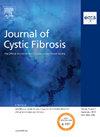ws08.02铜绿假单胞菌特异性IgG水平,elisa /tezacaftor/ivacaftor治疗前后
IF 6
2区 医学
Q1 RESPIRATORY SYSTEM
引用次数: 0
摘要
PA肺部感染是囊性纤维化(pwCF)患者的重要问题。对痰样本进行密切监测是国际标准,但在引入萃取器/萃取器/萃取器(ETI)后,这种监测系统变得困难。在丹麦,结合痰样本常规分析特异性PA免疫球蛋白G (IgG)。在这项研究中,我们试图检测PA感染的pwCF在ETI治疗前后特异性PA IgG水平。IgG、调节剂治疗和肺部感染的数据提取自丹麦囊性纤维化队列和国家微生物数据库。数据被分为四个不同的时间段:ETI开始前一年,以及开始后的第一年、第二年和第三年。根据痰微生物学结果,所有个体在每个时间段按照利兹标准进行分组。采用线性混合效应模型估计IgG水平。包括236个pwCF。根据利兹标准,ETI前的分布为“从未感染”22例(9.3%),“无感染”103例(44%),“间歇性”39例(17%)和“慢性”72例(31%)。在39例间断性感染中,24例变为“无感染”,但IgG无变化,差异为0.6 ELISA单位(-0.7;2.0)。72例慢性感染者中,19例在第3年的利兹标准中下降了至少一个水平,IgG下降了2.0个ELISA单位95% CI (1.0;3.0)。我们的研究结果表明,在常规痰液分析中使用IgG水平可以深入了解eti后PA感染状态的动态。在慢性感染者中,在ETI开始三年后观察到IgG水平显著下降,表明细菌负荷减少。相反,在间歇性感染的个体中,尽管分离的PA数量大量减少,但特异性IgG水平没有明显变化,这突出了尽管临床稳定,仍需要继续警惕监测PA。本文章由计算机程序翻译,如有差异,请以英文原文为准。
WS08.02Specific Pseudomonas aeruginosa IgG levels before and after elexacaftor/tezacaftor/ivacaftor treatment
PA lung infection is a significant concern in people with cystic fibrosis (pwCF). Close monitoring with sputum samples is international standard, however this system of monitoring has become difficult after the introduction of elexacaftor/tezacaftor/ivacaftor (ETI). In Denmark, routine analysis of specific PA immunoglobulin G (IgG) is used in combination with sputum samples. In this study we sought to examine specific PA IgG levels before and after ETI treatment among PA infected pwCF.
Data on IgG, modulator treatment and pulmonary infections were extracted from the Danish Cystic Fibrosis Cohort and national microbiology database. Data was grouped into four distinct time periods: One year before ETI initiation and the first, second and third year after. Based on sputum microbiology results, all individuals were grouped in accordance with Leeds criteria at each time period. A linear mixed effects model was used to estimate IgG levels.
236 pwCF were included. Distribution before ETI according to Leeds criteria was ‘never infected’ 22 (9,3%), ‘infection free’ 103 (44%), ‘intermittent’: 39 (17%) and ‘chronic’: 72 (31%). Among the 39 intermittently infected 24 shifted to ‘infection free’ but IgG was unchanged with a difference of 0.6 ELISA units (-0.7; 2.0). Among the 72 chronically infected 19 dropped at least one level on Leeds criteria by year 3 while IgG decreased 2.0 ELISA units 95% CI (1.0; 3.0).
Our findings suggest that the use of IgG levels with conventional sputum analysis offers insights into the dynamics of PA infection status post-ETI. Among chronically infected individuals, a significant decrease in IgG levels was observed three years following ETI initiation, indicative of a reduction in bacterial load. Conversely, in intermittently infected individuals, no significant change in specific IgG levels was noted despite a large decrease in number of isolated PA, highlighting the need for continued vigilance in monitoring PA despite clinical stability.
求助全文
通过发布文献求助,成功后即可免费获取论文全文。
去求助
来源期刊

Journal of Cystic Fibrosis
医学-呼吸系统
CiteScore
10.10
自引率
13.50%
发文量
1361
审稿时长
50 days
期刊介绍:
The Journal of Cystic Fibrosis is the official journal of the European Cystic Fibrosis Society. The journal is devoted to promoting the research and treatment of cystic fibrosis. To this end the journal publishes original scientific articles, editorials, case reports, short communications and other information relevant to cystic fibrosis. The journal also publishes news and articles concerning the activities and policies of the ECFS as well as those of other societies related the ECFS.
 求助内容:
求助内容: 应助结果提醒方式:
应助结果提醒方式:


